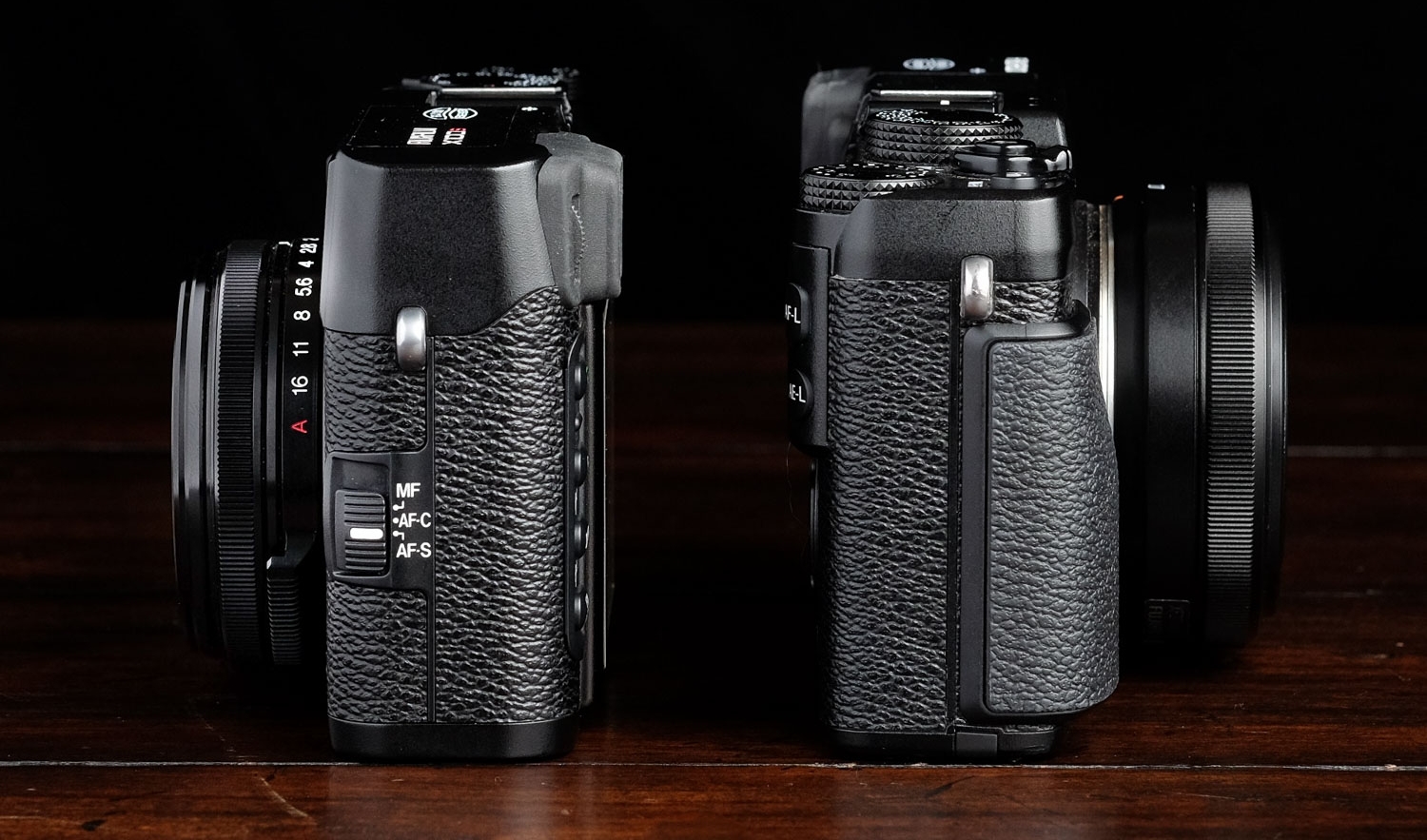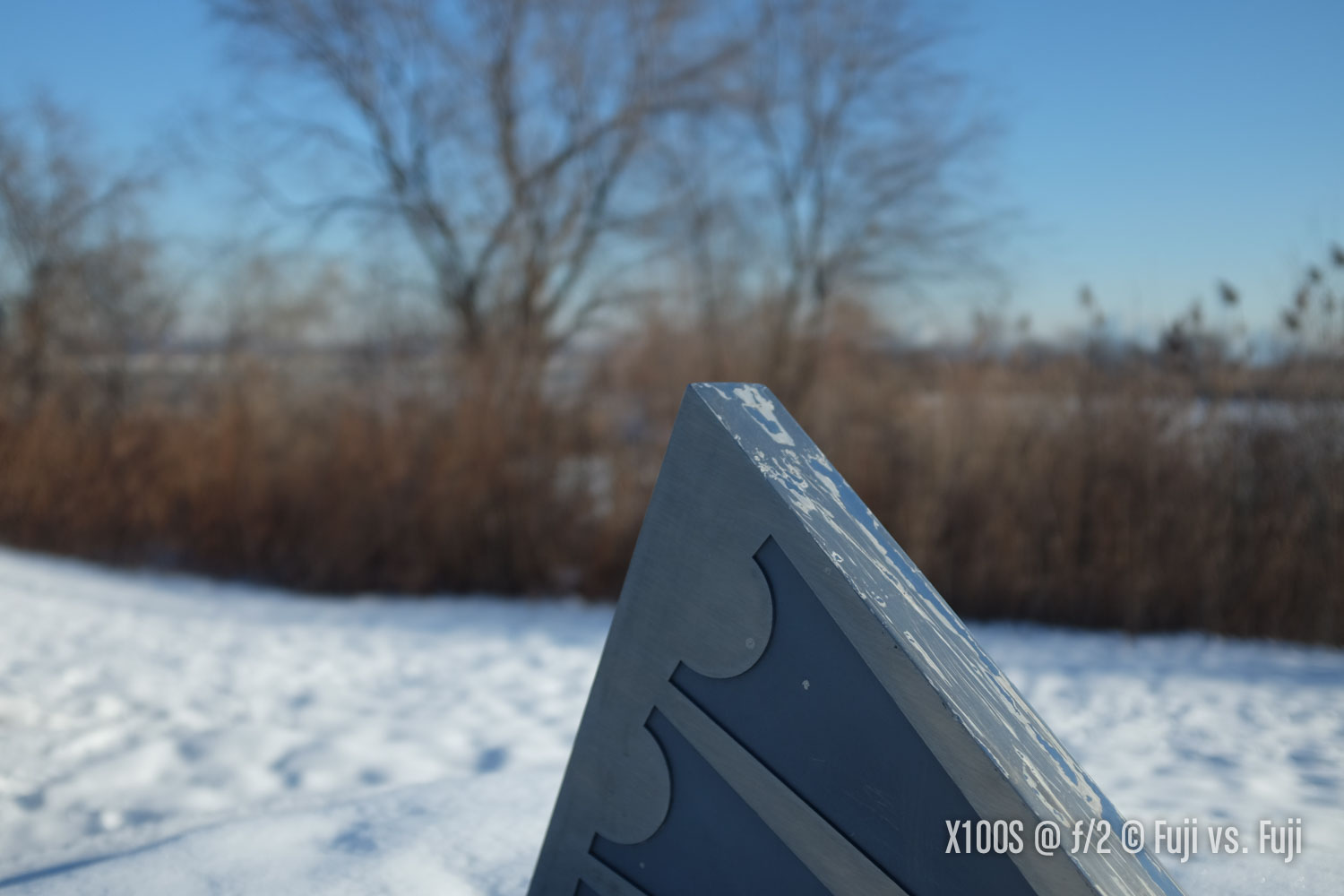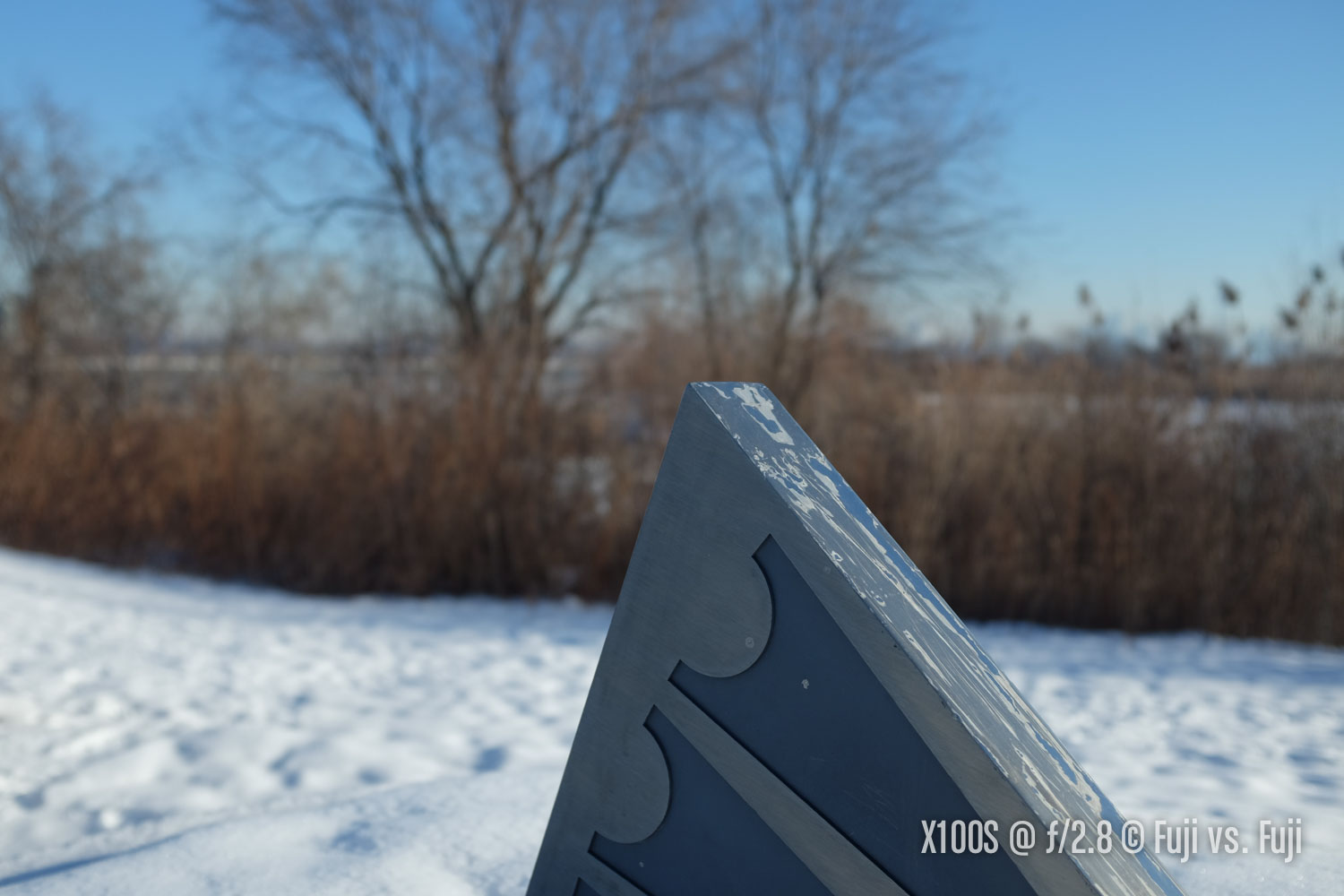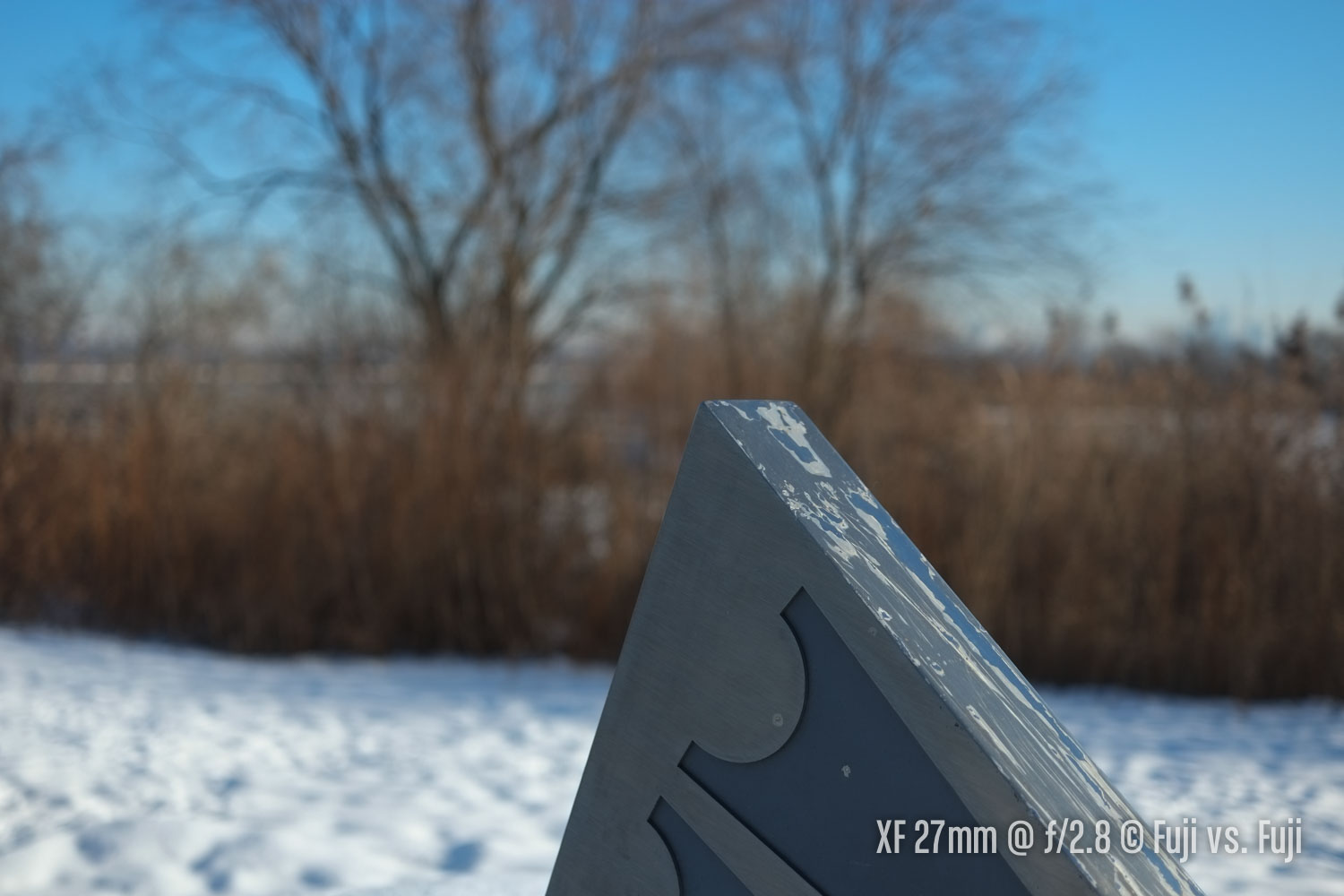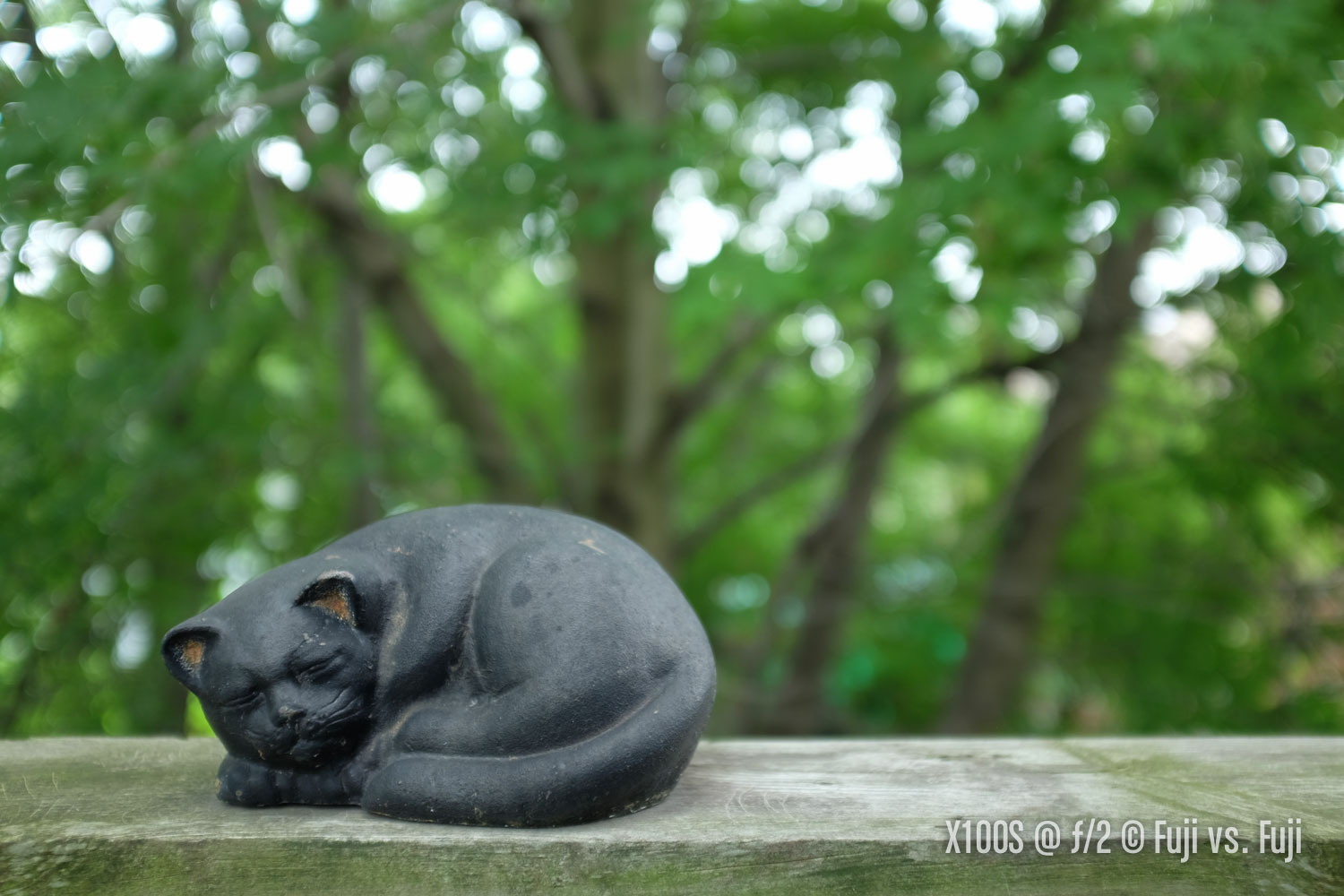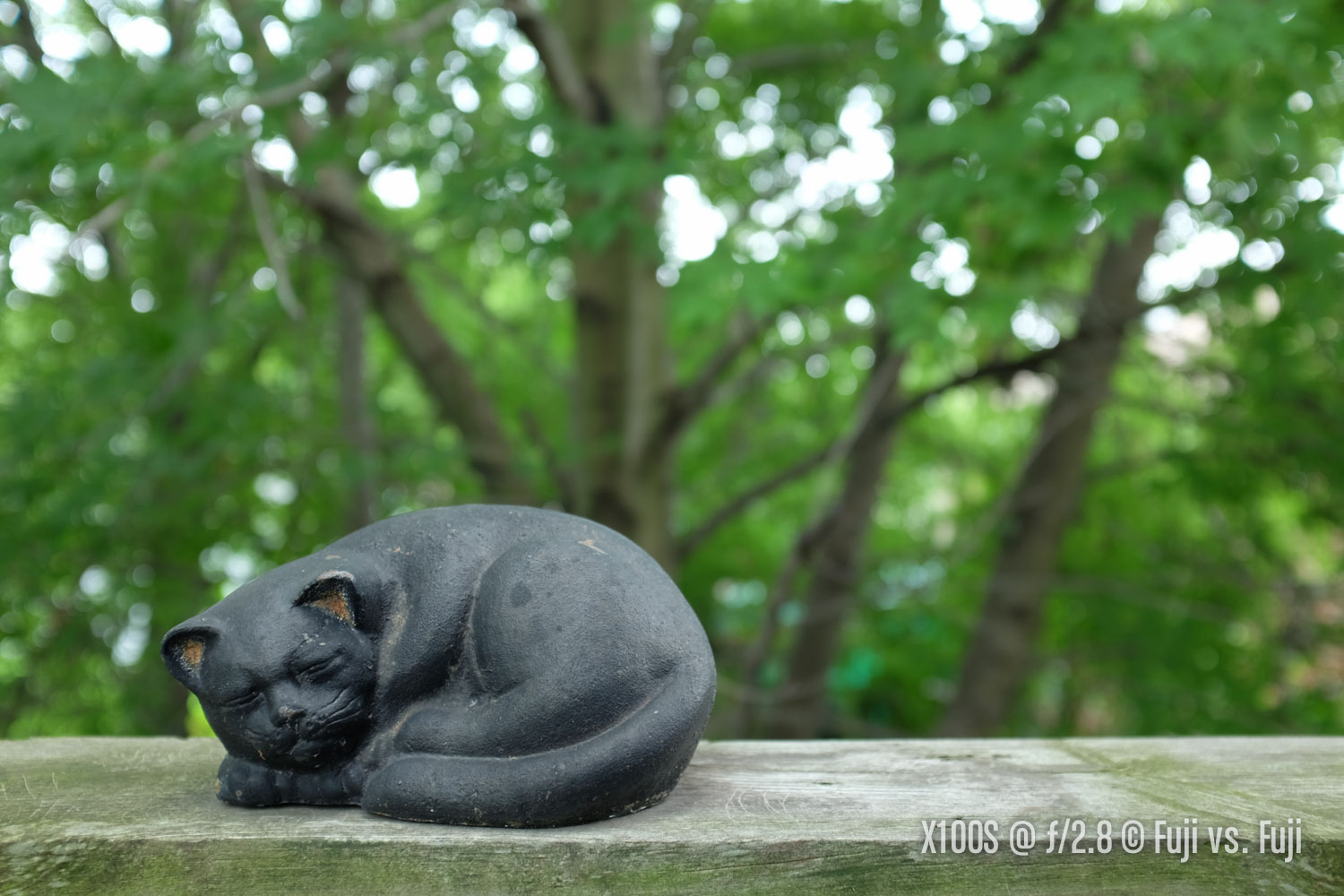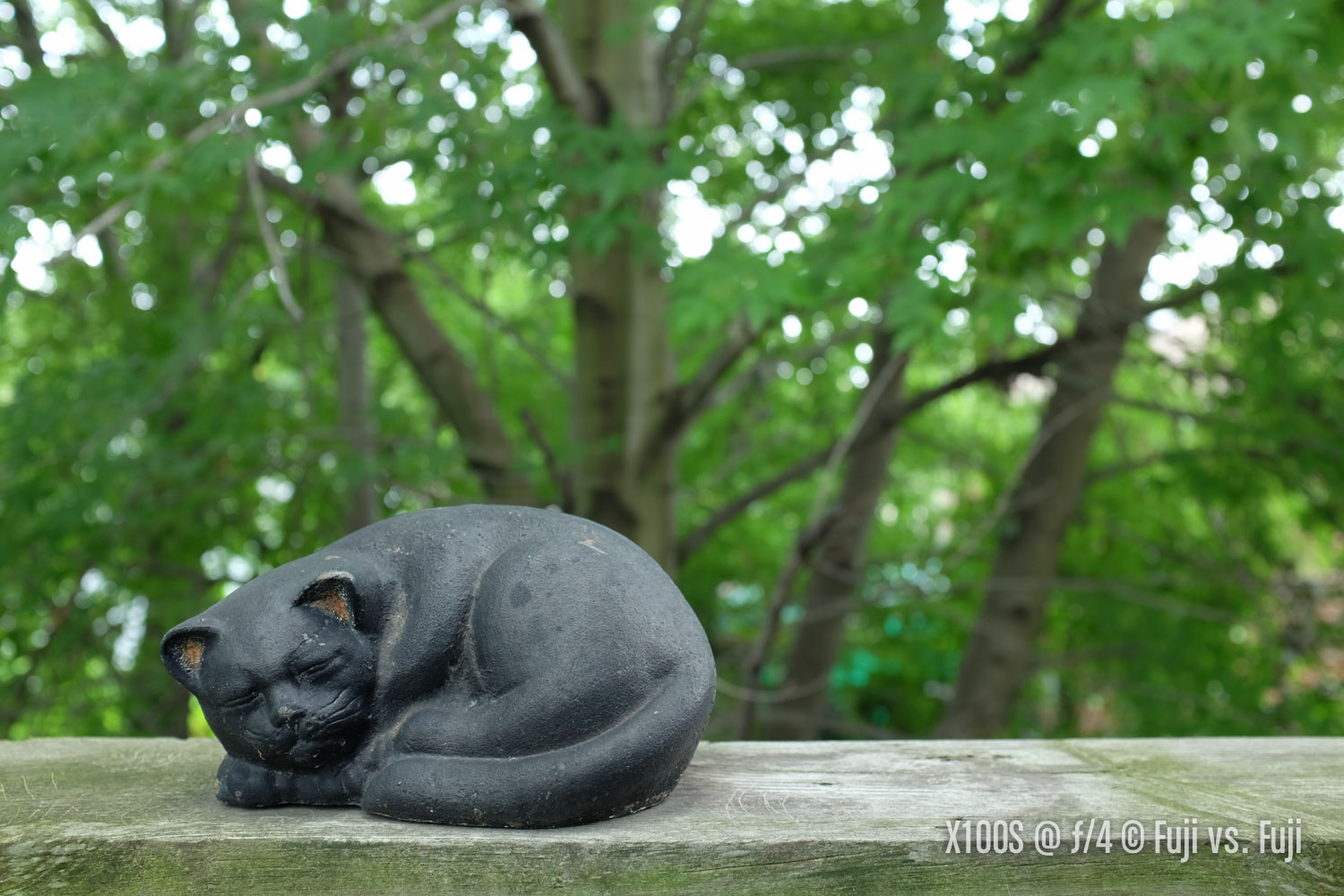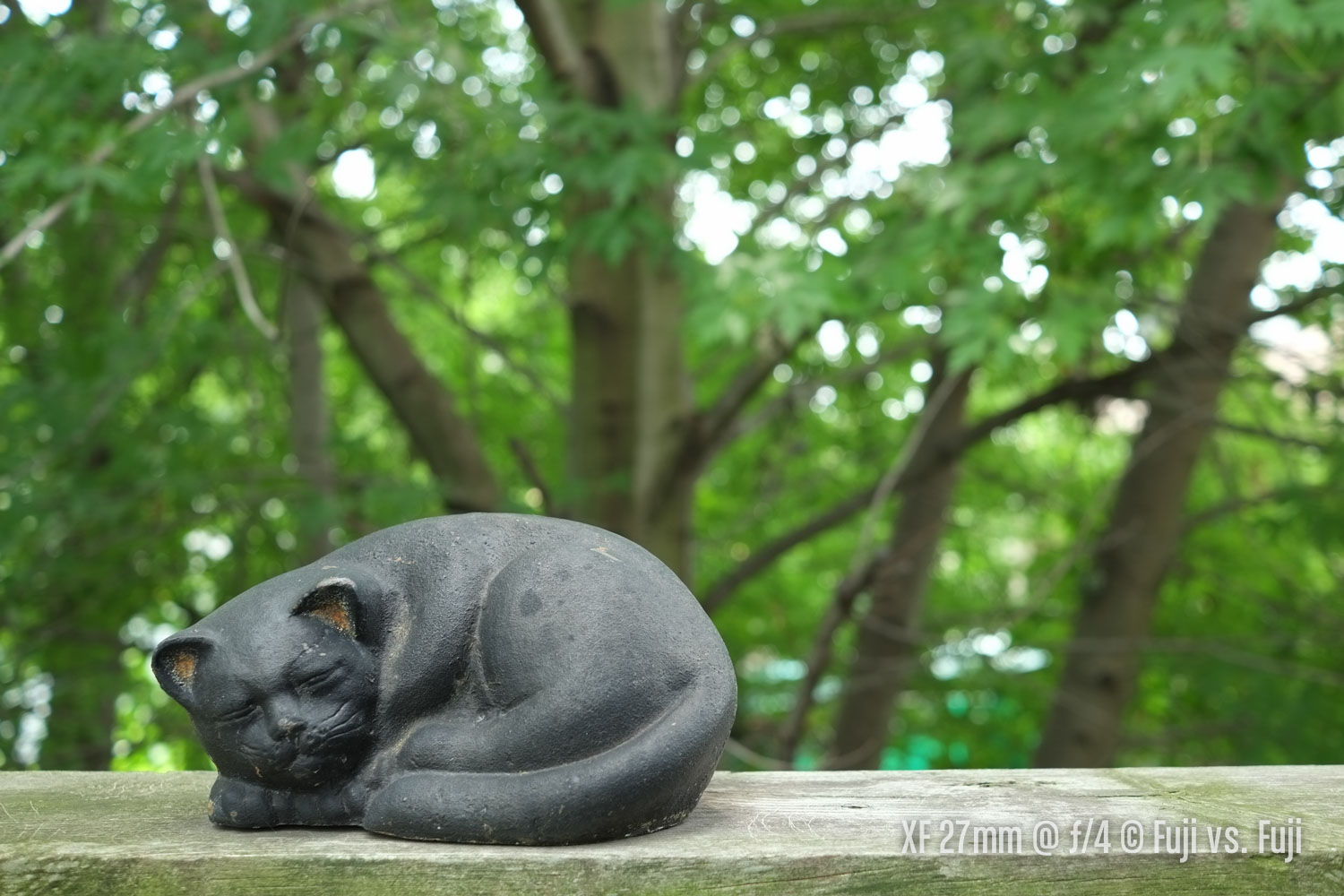This is a comparison between the 23mm FUJINON F/2 lens found in Fuji’s X100(S/T/F) and the FUJINON XF 27mm f/2.8 “pancake” mounted on an X-E2
Introduction
Possibly one of the most asked about comparisons before the XF 23mm F/1.4 was announced was how the X100S with its fixed 23mm f/2 lens stacked up against the XF 27mm F/2.8 on an X-E body. Do we need to buy an X100 in order to get such a small package, or would adding the XF 27mm F/2.8 to our current body produce optically similar results? Given the X100’s FUJINON 23mm F/2 lens has been honed to work as well as possible with its conjoined body, there are bound to be differences in how these two packages perform.
Specifications
| X100 23mm F/2 | XF 27mm F/2.8 | |
|---|---|---|
| Announced | January 7, 2013 | June 26, 2012 |
| Released | March, 2013 | July, 2013 |
| Lens Construction | 8 elements in 6 groups 1 aspherical glass molded lens |
7 elements in 5 groups 1 aspherical element |
| 35mm Equivalent | 35mm | 41mm |
| Angle of View | 63.4˚ | 55.5˚ |
| Aperture Range | f/2 - f/16 | f/2.8 - f/16 |
| Focus Range | 0.5m (10cm Macro) - Infinity | 0.6m (34cm Macro) - Infinity |
| Filter Size | 49mm | 39mm |
| Includes Camera | Yes | Camera sold separately |
Size & Weight
The XF 27mm F/2.8 is Fuji’s smallest lens by no small margin. It’s the lens every owner of an interchangeable X series body looks at when trying to match the exceptionally svelte package that is the X100. As seen above, even with the XF 27mm F/2.8 attached, X-E bodies still aren’t quite as small as an X100 on its own.
The interchangeable lens and body combination might not be quite as small as the X100 in size, but it can actually be slightly lighter at 426.5g mounted on an X-E body compared to 446g for the X100. The X100 is one of Fuji’s densest feeling cameras, and heavier than one might expect. If you’re looking for the absolute lightest option in this form factor, and X-E camera will save you a few grams.
Weight in Grams
Handling
The X100S was my first Fuji so the majority of my learning curve was spent with it. Initially when I got my first interchangeable lens body, I preferred the way the X100S operated. That has slowly shifted over time to preferring how the X-E2 handles overall. The X-E1 still has its quirks (why, after I change my AF point does “OK” send it back to middle? On the X-E2 and X100S, “OK” confirms your selection, and “BACK” sends it back to the middle, which makes sense), but aside from the AF button being in the wrong place on every camera but the X100S, I prefer how the X-E cameras operate.
Leaf Shutter
The leaf shutter + built-in ND filter is a huge boon to flash photogs, and it even came in handy during my tests as it was snowy outside which meant crazy fast shutter speeds. The X-E1 shoots at up to 1/4000th of a second so I didn’t have to worry about the shutter speed (as much). With the X100S, I was constantly having to turn the ND filter on, shoot wide open through to f/4, and then turn it back off. This is the edgiest of edge cases, and I probably didn’t need to turn the ND filter off. I like to make sure things are as equal as possible for these test shots though.
Aperture Ring
The X100S has an advantage in having a dedicated aperture ring. The aperture ring can also be frustrating. If you’re focusing manually and want to shoot through a couple apertures, it’s way too easy to move the focus ring accidentally. Again, this is an edge case, but some people are very quick the write the XF 27mm F/2.8 off due to it not having a dedicated aperture ring. The disadvantage of course, is moving back and forth between all the other XF lenses having a (configurable) dedicated aperture ring, and the XF 27mm F/2.8, the lone lens without.
Optical Viewfinder
And finally, there’s that glorious optical viewfinder on the X100S. Many people swear by it and cite it as reason enough to buy the X100S over a combination like the one I’ll be testing. It saves battery live, you can see what’s about to enter your frame, etc. There are a bunch of reason to love it. I love the OVF, but in my experience, it has led to more images with horribly missed focus. Not a huge amount more, but more. The EVF shows you without any doubt what is in focus. I’ll say it again, I love the OVF, but when I’m using my X-E2 with the 23mm f/1.4 attached, I can’t say I miss it.
Otherwise it’s pretty much even. Both lenses have equally fiddly lens caps by default, neither lens comes with a hood, and if you thought the 49mm filters for the X100(S) were small, check out the positively teeny weeny 39mm filters for the XF 27mm F/2.8.
Field of View
The field of view of these lenses is quite different, despite their focal lengths being numerically close. You’ll see in all the test images that the 27mm f/2.8 does get you a fair bit closer.
Sharpness
These are all RAF files, sharpened exactly the same, and otherwise unadjusted aside from minor normalizing of exposure (1/4000th of a second wasn’t quite fast enough on the XF 27mm F/2.8). Focus was on the building just to the right of centre. Click to enlarge.
The X100S is decent at f/2 in the centre of the frame, but only until you compare it to itself or the XF 27mm F/2.8 at f/2.8. The difference between the X100S at f/2 and f/2.8 is remarkable, but so is how sharp the XF 27mm F/2.8 is wide open. Let’s have a closer look with some crops.
As mentioned, the building doesn’t look too bad from the X100S at f/2, but have a look at the antennae to the left of it. The sharpness gained by stopping down to f/2.8 across the frame astounding. Equally astounding is that the XF 27mm F/2.8 is holding nearly as much detail wide open at f/2.8. I’m really quite impressed with how sharp this pancake lens is.
The sharpest apertures for each lens are f/5.6 and f/8 with f/4 being a hair softer on each. Diffraction sets in just barely at f/11, and quite heavily by f/16; enough that I’d avoid it when sharpness is important.
Next we’ll see how things are at apertures one might actually use for an image like this; f/8.
Things even out in the middle of frame. More detail can be made out on the XF 27mm F/2.8, but I chalk that up to the focal length rather than differences in sharpness.
Moving to the left edge though, and once again the XF 27mm F/2.8 is holding a little more detail. The X100S looks soft in the tree to the left of the building, but there was some wind that day which might account for it. Even on the building though, I think I have to give the XF 27mm F/2.8 the nod.
I wanted to be sure about my testing, which is why I did the shots above. I had initially taken the following images as a bokeh, sharpness combo. The bare trees are good for comparing bokeh at larger apertures and sharpness at smaller ones. Please forgive the totally drab photographs.
With these images, I knocked the brightness of the sky down a bit and balanced out the histogram so the detail could be seen easily. Again, I find the 27mm f/2.8 pulling ahead slightly in the sharpness department, particularly in the rocks and the chewed up dog toy. The trees in the background look about the same to my eye.
Bokeh! (and rendering)
I went into this test expecting a fairly even match. I figured the slightly wider aperture on the X100S and the slightly longer focal length on the XF 27mm F/2.8 would balance each other out.
Air India Memorial
First we’ll take a look at sharpness up close.
Once again f/2 on the X100S is the weakest by a fairly wide margin. Even at this distance the X100S is looking a little hazy, but we’ll see more of that below. By f/2.8 the X100S is sharpens up considerably, but I think the 27mm f/2.8 ekes out a little more sharpness wide open at f/2.8. Next we’ll look at some bokeh crops.
Here’s where things turn around for the X100S. The extra stop not only gives it an edge with background separation, but the out of focus rendering is slightly more pleasing. The branch just above and to the right of centre is more “nervous” on the XF 27mm F/2.8. The X100S is smoother at both apertures. The warmth of the XF 27mm F/2.8 is also very evident here.
It’s worth noting that when each lens is pushed to its close focus limits, the X100S would completely run away with the background separation crown. It’s capable of focusing much closer as we’ll see below.
Napping Cat
In this test, I reframed between cameras to give a better idea of background separation with the same composition. It was done at a much closer distance so the hazing effect of the X100S is quite a bit more prominent. Things get better by f/2.8 and sharpen up considerably by f/4. The XF 27mm F/2.8 is a bit sharper wide open, but the camera really wanted to back focus slightly in this test. I redid it a couple of times with the focus point at its smallest setting in the same area, and the results were consistent so I opted to leave them as is. I’ll need to investigate this further.
Falloff is also very noticeable here when the X100S is wide open. And finally, while the light was changing slightly, the warmer rendering of the XF 27mm F/2.8 is quite clear in the dark grey of the cat. Below are some crops. Click to enlarge.
For a little added bokeh goodness, here is the lakeshore image from above, shot at wider apertures. Slightly further distances from the point of focus seem to work in favour of the XF 27mm F/2.8.
Close Focus
If you’ve seen my X100S vs. XF 23mm f/1.4 post, you can probably guess what’s going to happen here. The X100S’s close focus capabilities are insane thanks to how close the lens elements are to the sensor. The XF 27mm F/2.8 doesn’t do to bad either. Click to enlarge.
Conclusion
When I entered the Fuji world, it was with the X100S, so I had 23mm in APS-C covered. Earlier reviews I’d seen for the XF 27mm F/2.8 weren’t exactly glowing, so it wasn’t really a purchase consideration. Now that I have this site as an excuse to tinker with as much Fuji gear as I can get my hands on, I’m glad I’ve had a chance to test it. It really is an excellent lens in a positively tiny package. It deserves it’s “pancake” designation.
This makes it interesting in terms of a recommendation. Before the X-E2, the 23mm f/1.4, and all the excellent firmware updates from Fuji, I’d have said anyone who can, should get an X100S. Now the X100S is a little less of a no-brainer, especially for those who already have an interchangeable body. For the cost of an X100, one could buy the XF 23mm F/1.4 and XF 27mm F/2.8 new. In fact, with Fuji’s recurring rebate program, the cost for the two lenses can be a fair bit less. What you end up with is a 35mm equivalent that’s superior optically and in terms of handling, and a 41mm equivalent that’s barely larger than the X100S (mounted on an X-E1/2), lighter and equally, if not more sharp. That’s really worth considering.
There’s something to be said for the romance of having a single body with a fixed focal length though. And there’s something about the X100 that just makes me want to use it. I can carry it around with me in a jacket pocket. And now that it’s available in black, my rational mind has a really hard time not selling my silver X100S so I can buy it again in black. UPDATE: As it turns out, I did just that. I can’t leave this post without also mentioning (again) how great the X100 can be for long exposure work. Add a 10-stop ND filter to the built-in 3-stop ND filter and you’ve cut 13 stops of light with a single piece of glass. This makes the X100S hugely versatile. Street, people, landscapes, long exposures. There’s really nothing it can’t do. Aside from change lenses, of course.


